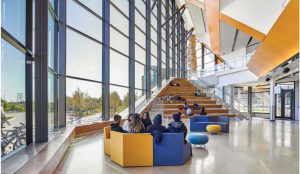
This net-zero energy building is a first for Humber College and is targetting LEED Platinum certification. The facility sets a precedent for innovation in automated manufacturing and human-centred solutions, omitting classrooms entirely. Instead, flexible project modules provide space for fabrication and technical zones for students, faculty, and industry to explore, research and fabricate together.
The experience of the BCTI begins the moment one steps onto campus. The building acts as a dramatic portal; its dynamic glazed lobby and cantilevered form creating a new focus for student life. The BCTI features active and social spaces like interactive demonstration areas and flexible open-concept gathering areas.
These spaces are designed to enable a free exchange of information and ideas to inspire an informal and active learning experience. The central atrium offers an immediate connection to the outdoors through views to surrounding landscaped spaces and campus and ample access to natural light. The building achieves net zero energy through a conservation first approach, driven by parametric analysis of solar radiation, daylight penetration, natural ventilation and envelope optimization, supplemented by a 700 kW solar PV array located on an adjacent parking structure. Beyond this, the project embodies a holistic approach to sustainability, in alignment with the College’s values: green rooftop teaching spaces, urban agriculture pods, and visible high-performance building systems that foster a culture of environmental stewardship as a vital aspect of entrepreneurial innovation. Materials have been chosen for low environmental impact, occupant health and wellbeing, durability and climate change resilience.
Estimated Savings
• Energy intensity (building and process energy) = 99.8 KWhr/m2/year
• Energy intensity reduction relative to reference building =
• 100% (all energy supplied by renewables)
• Water consumption from municipal sources = 1,559 litres/occupant/year
• Reduction in water consumption relative to reference building
• under LEED = 40%
• Recycled material content by value = 24%
• Regional materials (800km radius) by value = 34%
• Construction waste diverted from landfill = 85.3%